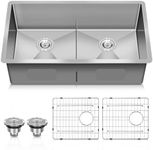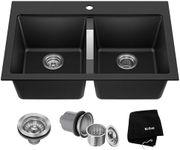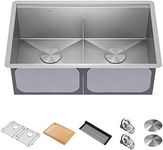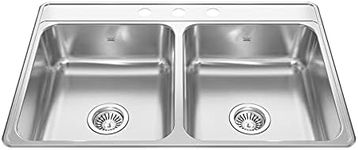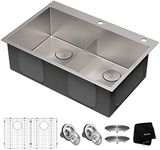Buying Guide for the Best Double Kitchen Sinks
Choosing a double kitchen sink is an important decision because it can affect how efficiently you use your kitchen space and how comfortable your daily tasks are. Double sinks offer flexibility for multitasking, such as washing dishes in one basin while rinsing vegetables in the other. To find the best fit, you should consider your kitchen habits, available space, and the way you like to work in the kitchen. Understanding the key features will help you make a choice that matches your needs and lifestyle.Basin Size and ConfigurationBasin size and configuration refer to the dimensions of each sink bowl and how they are arranged. Some double sinks have two equal-sized basins, while others have one larger and one smaller basin. This is important because it affects how you use the sink for different tasks. If you often wash large pots and pans, a larger basin may be more useful. If you prefer to separate tasks, like soaking dishes in one side and rinsing in the other, equal-sized basins might be better. Think about your typical kitchen activities to decide which configuration will make your work easier.
Sink MaterialSink material determines the durability, appearance, and maintenance needs of your sink. Common materials include stainless steel, composite granite, cast iron with enamel, and fireclay. Stainless steel is popular for its resistance to stains and ease of cleaning, but it can be noisy. Composite granite and fireclay are quieter and offer a different look, but may require more care to avoid chipping or staining. Consider how much maintenance you are willing to do and what style fits your kitchen best when choosing the material.
Mounting StyleMounting style refers to how the sink is installed in your countertop. The main types are top-mount (drop-in), under-mount, and farmhouse (apron-front). Top-mount sinks are easier to install and often more affordable, while under-mount sinks create a seamless look and make countertop cleaning easier. Farmhouse sinks have a distinctive front panel and can add a unique style to your kitchen. Your choice should depend on your countertop type, installation preferences, and the look you want to achieve.
Depth of BasinsThe depth of the basins affects how much you can fit in the sink and how comfortable it is to use. Shallower sinks (around 6-8 inches) are easier to reach into and may be better for people who prefer less bending, while deeper sinks (9-12 inches) can hold more dishes and reduce splashing. If you often wash large items or want to hide dirty dishes out of sight, a deeper sink may be best. Consider your height, how you use the sink, and what you typically wash to choose the right depth.
Divider HeightThe divider is the wall between the two basins. Some double sinks have a full-height divider, while others have a low or lowered divider. A full-height divider keeps the two basins completely separate, which is good for multitasking with different tasks. A low divider allows you to fill both basins with water or wash large items that don’t fit in one basin. Think about whether you need complete separation or more flexibility for large items when deciding on divider height.
Drain PlacementDrain placement refers to where the drain holes are located in each basin, such as in the center, rear, or corner. This affects how water drains and how much usable space you have under the sink for storage or plumbing. Rear or corner drains can provide more space for storing items under the sink and may help with better drainage when the sink is full. Consider your under-sink storage needs and how you want water to flow when choosing drain placement.

